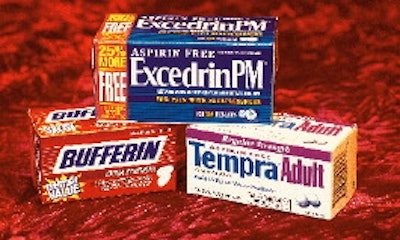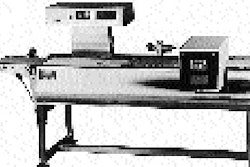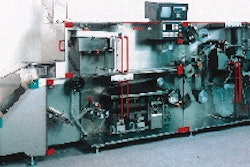Leveraging recent advances in the print quality of ultraviolet flexography, folding carton supplier Mebane Packaging Group (Mebane, NC) has introduced narrow-web UV flexo printing technology to cut packaging costs for a major customer, Bristol-Myers Products Div., Bristol-Myers Squibb, New York, NY. Most of Bristol-Myers' folding cartons were switched over from sheet-fed offset printing. Though neither company would disclose specific savings, both acknowledge that the move saves the over-the-counter pharmaceutical company well over 15% in folding carton costs. Mebane produces cartons for more than 200 SKUs of products such as Bufferin, Excedrin, Nuprin, as well as Ban Roll-on anti-perspirant/ deodorant. In the past, these and other name-brand OTC products have relied on cartons printed by offset to convey a premium image to consumers. But generics and store brands, often with simple, flexo-printed graphics, can retail for significantly less. Symbolizing the competitive issues faced by the name-brand OTC industry, Bristol-Myers wanted to reduce its packaging costs without giving up its graphic edge over the store brands. "This started off as a cost reduction measure in the purchasing area," comments Zarine Chughatta, a graphics manager in Bristol-Myers' packaging department. Compelling economics While Bristol-Myers' previous offset-printed cartons offered high-quality graphics, the off-set process is more labor-intensive than UV flexo. It requires as many as five individual processes and makereadies for sheeting, printing, die-cutting, sometimes stripping (where the trim is removed from the die-cut cartons) and finishing. It all adds up to a lot of setup and labor costs, with staging and shuffling of carton stock at each step of the way. The economics of the offset process favor large runs, requiring Bristol-Myers to tie up a lot of cash in folding carton inventory. Both Bristol-Myers and Mebane Packaging together sought a viable alternative. A little over a year ago, Mebane installed a 16" narrow-web UV flexo press from Comco Intl. (Milford, OH). Because the UV flexo press handles printing, die-cutting and stripping in a single pass, it requires much less setup time. And it only requires three workers, compared to 11 with the offset process. "When you take four processes and roll them into one, your labor costs are less, makeready time is reduced, and the entire production cost is reduced," says Jeff Robb, Mebane's director of graphic services. That translates directly into lower folding carton costs for Bristol-Myers. With the flexo press, jobs can be economical with quantities in the tens of thousands, while volumes on offset can require millions. Mebane now supplies Bristol-Myers on a just-in-time basis, greatly reducing the expense of extra inventory. "The flexo equipment doesn't run as fast as any individual machine in the offset process," Robb acknowledges, adding that Mebane operates the press at about 200'/min. "But you can still move a job through the operation a lot faster than with offset." For Bristol-Myers, that means a faster turnaround time for its print jobs. "If the plant calls and says they need more of a certain carton right away," explains Chughatta, "it's easier to put the job on the press quickly" than with offset. The press's ability to handle short runs also minimizes chances for Bristol-Myers' inventory obsolescence. "Mandatory regulatory copy changes are very frequent in the OTC business," says Chughatta. "We were really paying a lot [in wasted inventory]." Today, that cost been significantly reduced. The quality question Cutting costs is all well and good. But what about quality? "There is a long-standing stigma that flexo is just second-rate printing," says Robb. "I think flexo has improved so much in the last few years that a lot of those old ideas about flexo can no longer stand." While Robb says a trained eye can still tell a UV flexo-printed carton from an offset one, he maintains that "generally the consumer won't distinguish the difference on the shelf." Nevertheless, UV flexo quality still isn't offset quality, which initially proved a bit of a sticking point within Bristol-Myers. "The whole goal is to provide the quality that will continue to sell products while reducing their costs," Robb explains. "We understood in the very beginning there were going to be trade-offs." Chughatta acknowledges there was some adjustment in philosophy within Bristol-Myers to accept a switch to UV flexo. "We had to work with marketing to educate them" about both the capabilities and the limitations of the technology, she says. Eight stations Mebane's 16" Commander press from Comco sports eight print stations, seven used for color, one for coatings. Most of Bristol-Myers' cartons are printed with five to seven colors plus a gloss coating. The press can print both water-based inks or UV-cured, but Mebane primarily uses the latter. "With UV inks," says Robb, "we achieve strong, rich colors." Another advantage of UV inks is better color consistency. "With water-based inks," Robb explains, "there is a range of normal color variation from dark to light," requiring constant attention during the press run. With UV inks, "once you establish the color, you've got that color for the whole run." UV printing also permits finer screens and smaller type, contributing to better print quality. Clean-up is faster, too. "It's a lot quicker to move the UV inks in and out of the press," comments Robb. Mebane prints mostly 16-pt recycled board and 18-pt SBS from a variety of suppliers, already slit down to the 16" web width. The repeat is 24", so each form is 16x24". Bristol-Myers specifies 100% recycled board with 35% post-consumer content, which Robb admits poses a challenge to the press operation. "Recycled board requires more intensive web cleaning, web guiding, tension control and maintenance," he says. At the beginning of the press, two rolls of the material are mounted on a dual-roll butt-splicing mechanism. When one winds down, the second roll is automatically spliced on the fly without affecting run speed. Material unwinds from the roll and passes through a de-curling station and then through a front and backside vacuum system that removes slitter dust from the board manufacturer. The board then snakes through each of the eight print stations. Each station has a metering roll that pulls ink out of the well and applies it to the anilox roll. The anilox roll contains microscopic wells that hold the ink, distributed evenly with the help of a doctor blade. The anilox roll then distributes the ink onto the photopolymer plate, mounted on a roll, which contains a relief of the graphic image. The plate then applies the ink to the substrate. A UV lamp then cures the ink before the board enters the next station. Web inspection maintains quality One addition to the press that helps Mebane maintain quality is a web inspection system from CC1 (Manchester, NH). "Not only does it let you freeze the action while the job is running, it displays a magnified image of a carton's graphic elements on the video screen." The other unique aspect of the system is that it records each part of the makeready process as well as any unscheduled downtime. "We are continuously recording and reporting production data in real-time, and we can break down a run by each production step in terms of time and cost." After the board is printed and coated, it enters a KempSmith (Milwaukee, WI) flat-bed die-cutter that's married to the Comco press. Mebane chose a flat-bed press because its personnel are experienced with flat-bed die-cutting. "If we have a problem with a die knife, we can make a quick repair versus sending a rotary die back to a manufacturer," says Robb. Plus, there's an economical advantage: "Rotary dies cost considerably more than flat-bed dies," says Robb. That's critical, given the 50+ carton shapes and sizes that Mebane supplies to Bristol-Myers. Each die consists of a wooden board with slots burned into it with a laser according to the desired carton outline. Steel rules are placed in the slots, sharp ones for cutting and rounded ones for scoring. After the cartons are die-cut, a stripping system within the die-cutter automatically removes all waste from the die-cut form. A tab breaker delivery section then separates and shingle-feeds individual printed cartons onto a takeaway conveyor. There, operators gather, inspect and stack cartons, which are then sent to the gluing department. Robb says he's pleased with the press and the service he receives from Comco. In fact, it's the service and support capabilities that were deciding factors when it came to selecting a press supplier, says Robb. "It came down to responsiveness. They proved able to do what they said they could do, better than the other press manufacturers vying for our business." The result is a printing technology that allows Bristol-Myers to balance its need for cost reduction with an acceptable form of high quality reproduction. "UV technology is cutting edge for flexographically printed folding cartons," concludes Robb. "Most other companies are running water-based inks. UV is kind of the frontier that's not been completely explored, yet it's really proven itself for us. We're really pleased with the result."
























